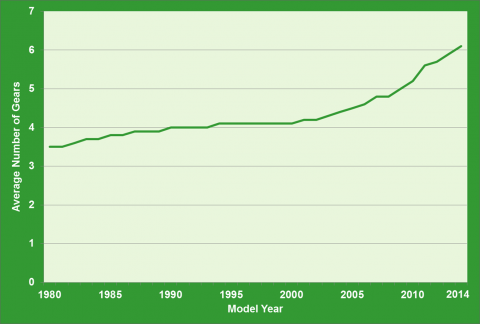The number of gears in a transmission affects a vehicle's fuel economy and performance. The more gears a vehicle has, the more time the engine spends within an optimal operating range while the vehicle speeds up and slows down. To achieve a better match between engine speed and wheel speed, manufacturers have been increasing the number of gears in the vehicles offered. In model year 1980, the average number of gears in light vehicles produced was just over 3, and that average rose only to about 4 gears over the next two decades. But beginning in 2001, the number climbed from about 4 gears to just over 6 gears in model year 2014.
Average Number of Gears in New Cars and Light Trucks
Note: Based on production. 2014 production data are preliminary.
Supporting Information
| Model Year | Gears |
|---|---|
| 1980 | 3.5 |
| 1981 | 3.5 |
| 1982 | 3.6 |
| 1983 | 3.7 |
| 1984 | 3.7 |
| 1985 | 3.8 |
| 1986 | 3.8 |
| 1987 | 3.9 |
| 1988 | 3.9 |
| 1989 | 3.9 |
| 1990 | 4.0 |
| 1991 | 4.0 |
| 1992 | 4.0 |
| 1993 | 4.0 |
| 1994 | 4.1 |
| 1995 | 4.1 |
| 1996 | 4.1 |
| 1997 | 4.1 |
| 1998 | 4.1 |
| 1999 | 4.1 |
| 2000 | 4.1 |
| 2001 | 4.2 |
| 2002 | 4.2 |
| 2003 | 4.3 |
| 2004 | 4.4 |
| 2005 | 4.5 |
| 2006 | 4.6 |
| 2007 | 4.8 |
| 2008 | 4.8 |
| 2009 | 5.0 |
| 2010 | 5.2 |
| 2011 | 5.6 |
| 2012 | 5.7 |
| 2013 | 5.9 |
| 2014 | 6.1 |
Source: U. S. Environmental Protection Agency, Light-Duty Automotive Technology, Carbon Dioxide Emissions, and Fuel Economy Trends: 1975 Through 2014, EPA-420-R-14-023, October 2014. | |


